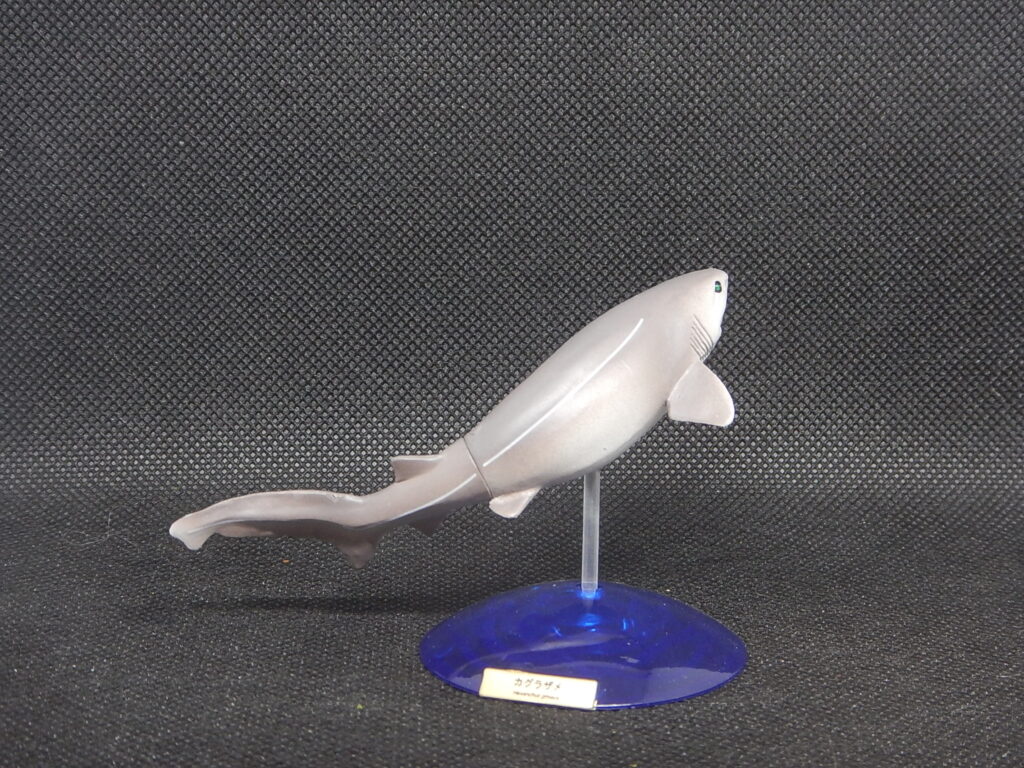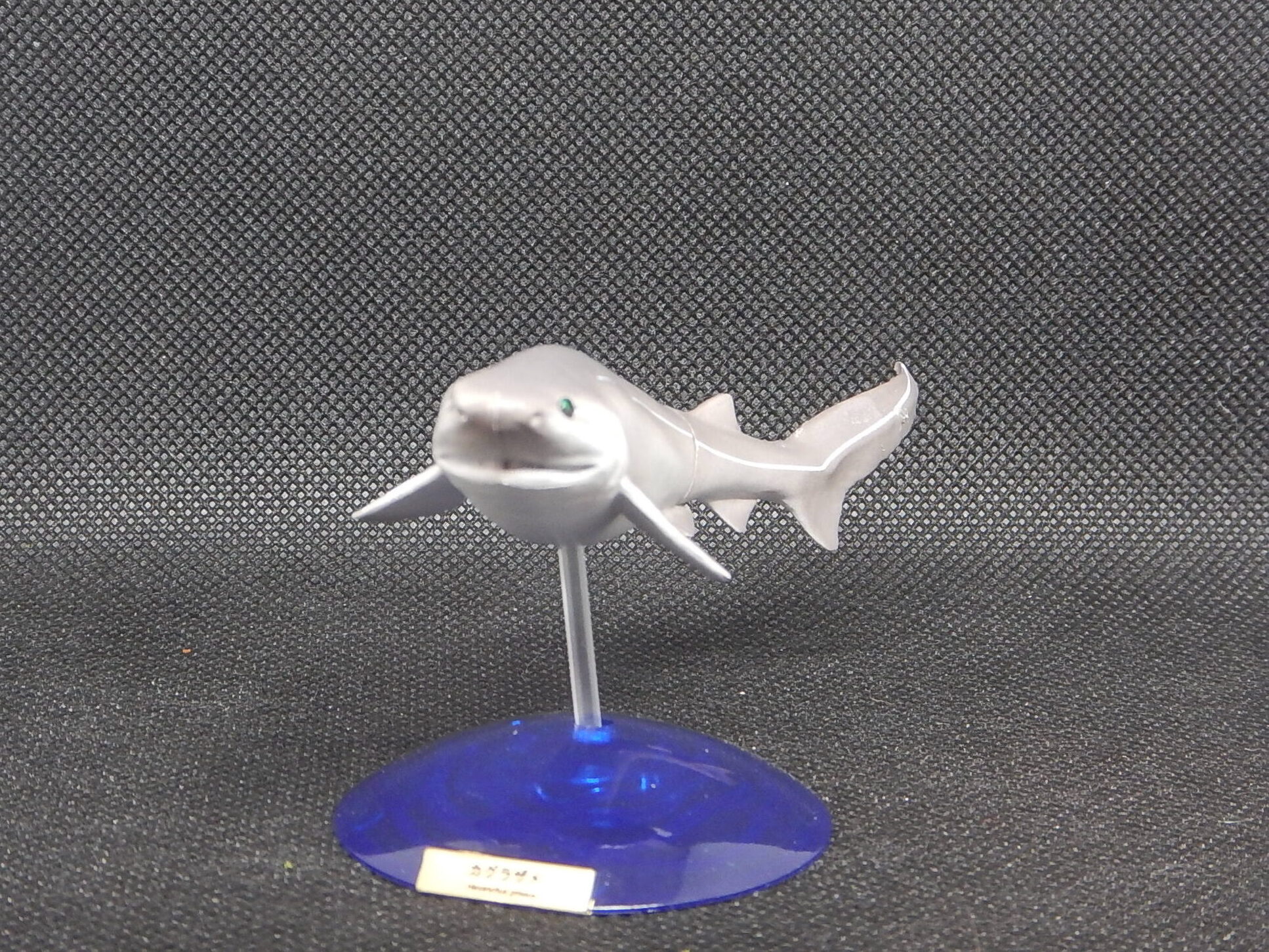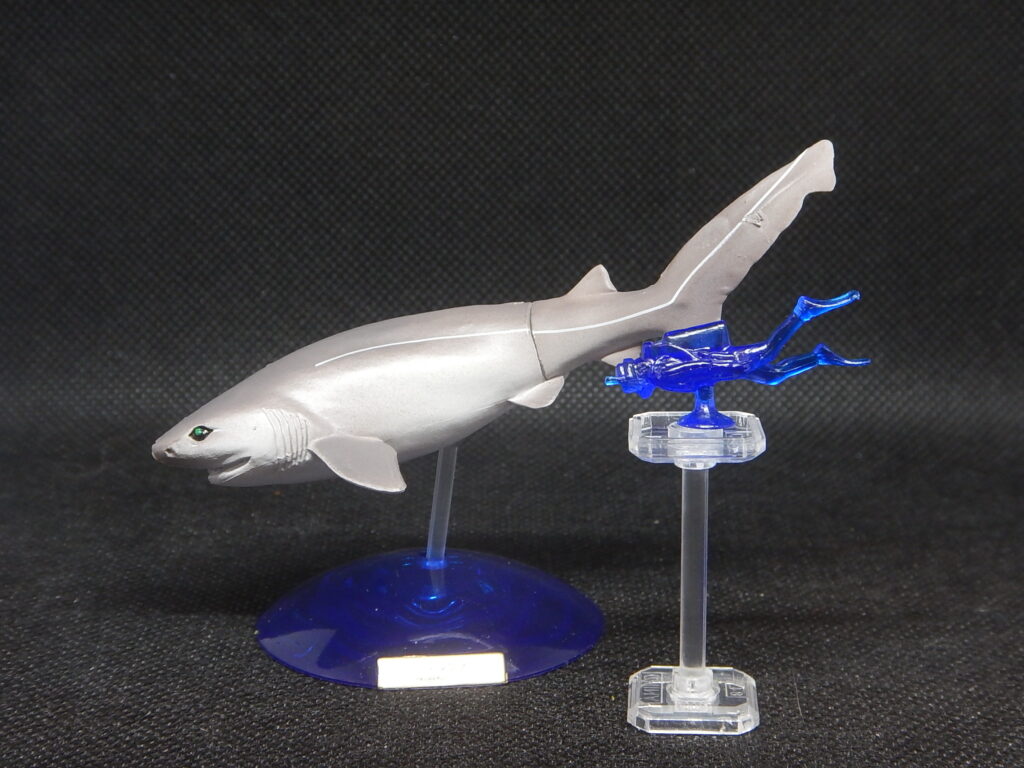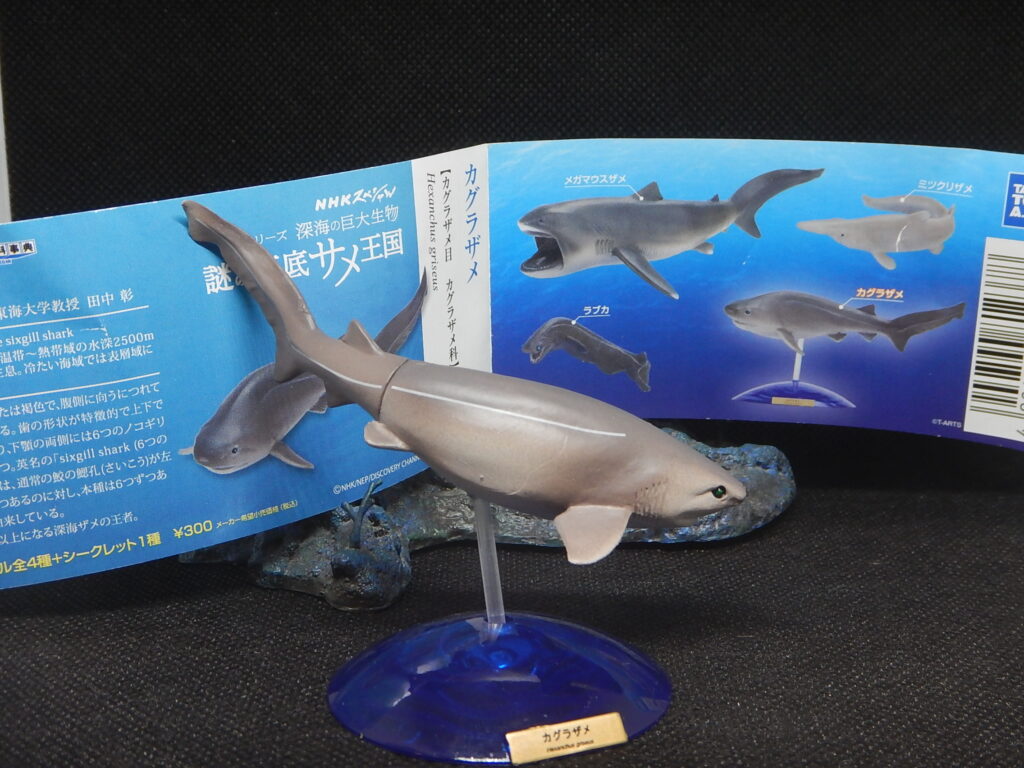I’m actually back! It has been quite a while since I added to the blog here (amongst everything else, I’ve been busy with my own thing!) But a call went out that Shark Week was coming up, so we needed more sharks! I knew I needed in, but wanted to look at a figure, and species, that would be less familiar. And I think this one covers those bases. Plus, there’s some kind of Discovery Channel connection! Somehow! The species is Hexanchus griseus, the Bluntnose Sixgill Shark, from a Takara Tomy capsule series NHK Deep Sea Sharks; this set was made in conjunction with Discovery Channel, but I don’t know those details.

Sixgill sharks are among an order of what are considered the most primitive living sharks, the Hexanchiformes. Within this group are included the very odd frilled shark (although those are sometimes in a different order), and the sixgill and sevengill sharks, AKA cow sharks. All of these sharks are notable for having only one dorsal fin, no nictitating membranes on the eyes, and six or seven gill slits (as opposed to the usual five seen on all of the rest of the living sharks). Fossil hexanchids are known from the early Jurassic, although there are potential teeth from as early as the Permian and even the Devonian.

The species seen here, the bluntnose sixgill shark, is similar in overall form to other members of the family. They are bathydermesal, indicating a deep sea environment, and appear to have a global distribution throughout the temperate and tropical oceans. They are highly predatory, with a very large caudal fin that allows quick bursts of speed for a fish that might otherwise move fairly sluggishly. The nature of their prey ranges from other sharks and rays, to marine mammals, bony fish, and invertebrates (cephaloopods). Apparently, studies of their gut contents have noted a shift; earlier studies indicated more fish in the diet (chondrichthyan and osteichthyan) followed by mammals and inverts. Later studies have shown a shift to cephalopods, then fish and mammals. The shift is not well-understood; it could be sampling or some kind of environmental shift; clearly these sharks are adaptable. They are also currently regarded as Near Threatened, as being large sharks with slow growth rates, but being popular as a sportfish could make them vulnerable.

Bluntnose sixgill sharks are large sharks, with males averaging 3.1-3.3 metres and females reaching 3.5-4.2 metres, with 4.8 metres being considered the usual TL. Apparently lengths of 5.5 metres could be reached (and maybe as much as 8 metres, which would be crazy!) They have big broad heads, and small eyes, which have shiny green with black pupils. The colour ranges from tan to beige or black. A light-coloured lateral line is present, and there is a white margin on the fins. There are often small darks spots on their sides. So, how did Takara do with this figure?

First off, the figure has definitely captured the broad, short head and long tail. Very importantly, they have the six gills clearly sculpted, which would be absolutely necessary! The overall shape of the body is represented well, with the heavy main body and long, extended posterior body and long caudal fin. The colour looks pretty good, as a lighter specimen. It is painted as mostly a dark taupe to grey, with a counter-shaded fade to a white belly. The white lateral line is present from above the gills to the tip of the tail. It seems like the colour on the line is very exaggerated, but at least they included it, so someone was paying some attention. There are, however, no hints of dark spots or markings anywhere on the body, but it isn’t too noticeable.

One the ventral side, there is a prominent indentation, but I am not sure where that came from. There is also, of course, the entry point for the ball joint on the stand, giving a decent range of motion for poses (the base is also ball-jointed) The figure, as is often the case, has been sculpted as a female, but this seems quite logical, as there is a distinct (some might say unfortunate) seam right at the point that claspers would have crossed, between the pelvic and anal fins. This would be a consequence of being a capsule figure that was made to be larger; it gives a better sense of their size, but does mean it is in pieces (as is the Megamouth shark, also in the set). Detailing is minimal, as the real sharks tend to be quite sleek, but there are clearly sculpted ripples in the fins and along the body. Overall, a great model of a shark we don’t usually see.

The figure measures about 9.7cm long, so it would range anywhere from 1:30 for a small male, to 1:80 for a highly unlikely 8 metre specimen. Assuming that ‘normal average’, and being female, it would be about 1:50 (so that diver would be a smaller human). This size allows the figure to fit in well with other sets of small sharks, and would definitely be a great way to augment a collection of them (again, I am only aware of one other sixgill shark and it’s…not the same level). The material is a softer PVC type, so the figures can withstand handling and play–and that’s good, because at this point you’re only going to find them in aftermarket sales; the series came out maybe…8 years ago? I got mine in 2013. Having discovered it the same day I mentioned to my son that we could really use a good sixgill or sevengill shark figure! Fortune! But it took a while, since it came from Japan…

The figure was released as in a Takara 3D capsule series of four (…or…five!!?) shark figures in a series referred to as the NHK Deep Sea Sharks. NHK is a television programmer in Japan that probably does a lot, but I am only familiar with a few sets of figures based on their shows! In this case, the series may have been produced in conjunction with Discovery Channel–if you look closely in the info tag, the copyright notice also mentions Discovery! So this may have actually been a Shark Week program as well (I don’t know…I don’t have the channel, and haven’t for many years). I do have the four species in the series…but my goblin shark is a bit different; it’s a feeding chase figure! There are actually other Takara shark series from a similar time with similar sculpts (never the sixgill again, sorry), but you can spot the NHK Sharks series by the base; other Takara shark and deepwater sets have a flattened disk for a base, the NHK sharks have the raised dome with a gold label. I highly recommend this figure for shark and fish figure lovers, but I do hope we see more well-made cow sharks soon!
Disclaimer: links to Ebay and Amazon on the AnimalToyBlog are affiliate links, so we make a small commission if you use them. Thanks for supporting us!




This species is on my ‘Safari wishlist’!